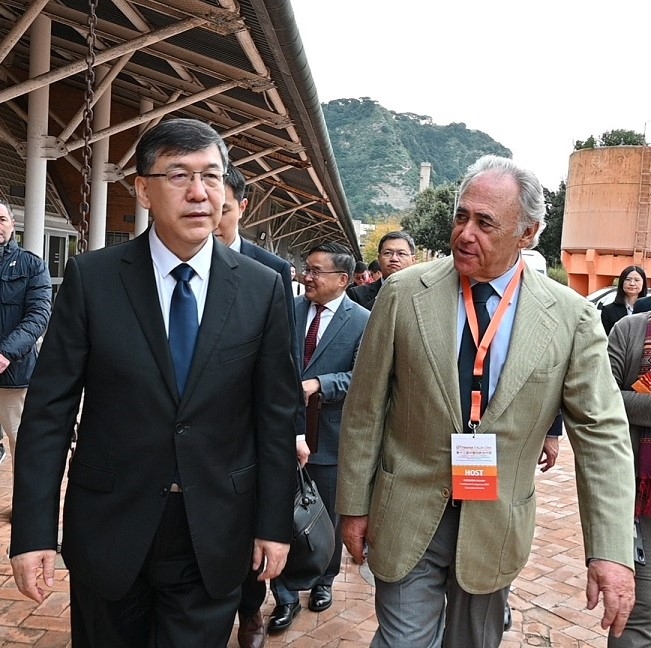NVIDIA: The “Beating Heart” of Artificial Intelligence

What strategy has enabled the extraordinary rise of NVIDIA , the company that has surpassed a $5 trillion market cap, redefining the balance of global technological geopolitics? We discuss this with Antonino Caffo, a journalist and expert in AI and digital technology.
What are the strategies and main factors that have allowed Nvidia to reach the historic threshold of 5 trillion in capitalization, surpassing giants such as Apple and Microsoft?
Nvidia's achievement of a $5 trillion market cap, a milestone that has seen it surpass established giants like Apple and Microsoft, isn't the result of a single event, but of a multi-year strategy that has culminated in near-absolute dominance in the industry that is defining the current technological era: artificial intelligence. The primary factor was the strategic foresight of the company and its CEO, Jensen Huang, in recognizing that its Graphics Processing Units (GPUs), originally designed for gaming, possessed the ideal parallel computing architecture for training complex AI models. This insight transformed Nvidia from a gaming hardware company into the indispensable supplier of "picks and shovels" for the new AI gold rush.
How has the AI boom affected Nvidia's growth, especially in the GPU market and in the data center and supercomputer sectors?
The AI boom hasn't just impacted Nvidia's growth: it's literally redefined it, transforming it from a leading gaming company to a technology giant serving as the infrastructure cornerstone of the entire digital economy. The impact has been profound, directly impacting the GPU, data center, and supercomputer sectors, which have become the primary drivers of its revenue and valuation.
What are the potential financial and “bubble” risks associated with Nvidia’s current value, given the warnings economists and investors have raised about AI-driven technology stocks?
The rise has inevitably sparked a debate about the risk of a speculative bubble, with many parallels drawn to the dot-com bubble of the early 2000s. The main concern, highlighted by institutions such as the International Monetary Fund and the Bank of England, lies in a potential disconnect between stock market valuations and the actual revenues generated by AI applications. Price-to-earnings (P/E) ratios for AI-related stocks, Nvidia first and foremost, have reached very high levels, suggesting that investors are pricing in future growth expectations. The risk is that if the appetite for AI investments cools, or if the monetization of these technologies proves slower or less profitable than expected, a sharp and severe market correction could occur. The enormous costs of building the data centers needed to power AI represent another vulnerability. Some critics, while acknowledging the transformative importance of AI, argue that investor enthusiasm is excessive and that the market is underestimating the risks. On the other hand, figures like Nvidia CEO Jensen Huang have repeatedly rejected the idea of a bubble, arguing that what we're witnessing isn't speculation, but a fundamental "structural shift." According to this view, the adoption of AI by real industries, governments, and multinationals is a concrete, long-term infrastructure investment, similar to building electricity grids or the internet. The debate, therefore, is less about the importance of AI than the sustainability of current valuations and the speed with which investments will translate into tangible, widespread profits.
How are tensions between the United States and China, including restrictions on chip exports and diplomatic moves by figures like Trump and Xi Jinping, affecting the future of Nvidia and the global semiconductor market?
The tensions represent one of the greatest risks and, at the same time, a strategic redefinition for Nvidia's future. The US government has identified advanced semiconductors as a critical technology for national security and military supremacy, leading to the imposition of severe restrictions on the export of Nvidia's most powerful AI chips to China. These measures have directly affected the company's business: China, which once accounted for a significant share (around 20%) of Nvidia's revenue, is now seen as a shrinking market for its flagship products. These restrictions have had a direct financial impact, with losses estimated at billions of dollars for specific chips (such as the H20) that were specifically designed to comply with previous, later tightened, regulations. The more profound impact, however, is strategic. On the one hand, Nvidia is losing access to the fastest-growing market for AI; on the other, US restrictions are exponentially accelerating China's efforts to achieve "technological self-sufficiency." Beijing is investing heavily in the development of its own AI processors, led by companies like Huawei, seeking to create an alternative, independent ecosystem.
What role does Nvidia intend to play in the global AI ecosystem in the coming years, including through strategic partnerships, investments in emerging sectors (such as 6G and robotaxis), and relationships with institutional and private players in the US, China, and Europe?
Nvidia no longer intends to be just an AI hardware provider, but aims to become the architect and operator of the critical operational infrastructure for the next phase of the digital economy. Its future role is that of a true AI "utility," whose hardware and software ecosystem (CUDA) will be as essential to industry as electricity is today. To achieve this goal, it is pursuing an aggressive strategy of expansion and vertical and horizontal integration. Investments in emerging sectors are emblematic of this strategy. The billion-dollar investment in Nokia is not just a bet on 6G, but a plan to infuse AI directly into the heart of future telecommunications networks. The goal is to create "intelligent networks" capable of handling AI workloads directly at the edge, powering everything from industrial IoT to augmented reality. Likewise, the partnership with Stellantis and Uber for robotaxis (with production planned for 2028) demonstrates the desire to provide the "brain" (its autonomous driving platform) for one of the fastest-growing and most intensive sectors of the next decade.
Rai News 24




